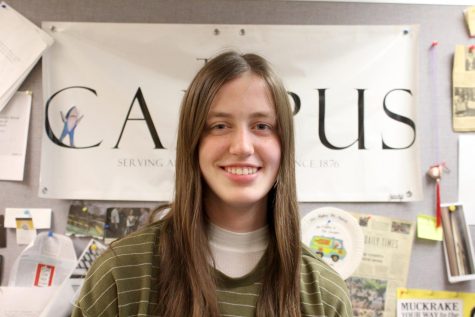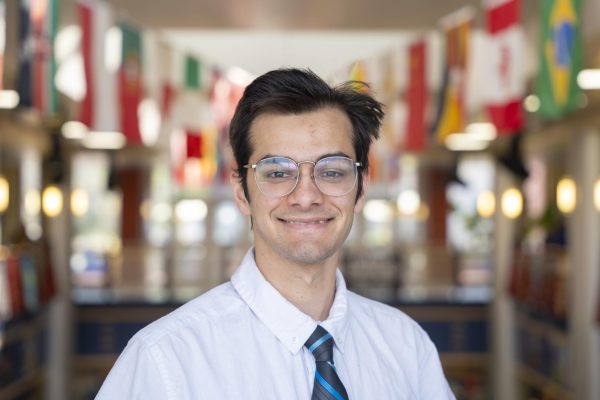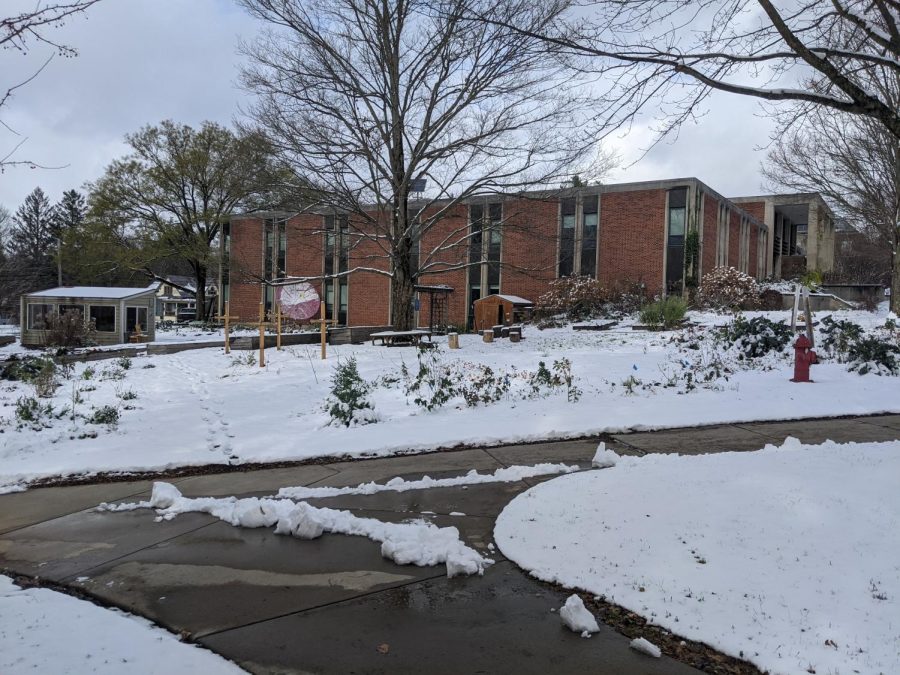“Food Forest” celebrates its first harvest
The now-dormant food-forest is located next to the Carrden and Carr Hall.
As the year comes to an end, the “food forest” celebrates its first harvest season. What began as an idea by a motivated first-year has been cultivated into a devoted community as it grew to fruition. Today, the forest stands as a landmark of the difference that a group of motivated individuals can make at Allegheny College.
“Honestly, probably my favorite part of my journey in this college is that it was a small group of students,” said President of the Sustainable Design Team Ashlynn Peachey, ’23. “A group of just really passionate students that put in the work were able to make a change on campus. I think that’s the best part of Allegheny is that we could do that.”
The idea of the food forest began four years ago with Sebastian McRae, ’22, and his dream of bringing permaculture to campus. He worked with professors and student groups like the students for environmental action to form the SDT. Peachey joined this group during the 2019-20 academic year — her first year at the college — on a whim. During the first meeting, she realized that she was in the right place.
“These are my people,” Peachey said. “This is fantastic.”
McRae’s graduation last year allowed the group to transform from a classroom environment to a collaborative effort.
“I think the first few years it was Sebastian coming in and teaching us how all of this was supposed to happen,” Peachey said. “But now it truly feels like a conversation. This is a conversation and there’s a ton of different voices and there’s a million different factors that come into any choice that we make.”
The group worked closely with Director of Sustainability Kelly Boulton, ’02, to make a reality of their dream: To transform a plot of unused land into a garden utilizing permaculture.
“Permaculture is a way of learning from nature and mimicking nature to develop planted areas that are going to be the strongest they can be,” Boulton said. “The other thing about the food forest is that you are thinking about a stratification of plants: there are fruit trees that are planted which are larger, there are fruit bushes which are planted which are mid-story and then there are smaller understory plants that grow in around it. It uses the space of a garden really efficiently and it’s also something that establishes itself and should be self-sustaining.”
These alternative agricultural practices stem from Indigenous knowledge, according to Assistant Professor of Environmental Science and Sustainability Jesse Swann-Quinn, the adviser of SDT. One of the goals of the forest is to acknowledge these roots and educate students about them. Last semester, Peachey’s junior seminar class, led by Swann-Quinn, earned a grant toward signage that explains these roots and how the practice works.
Despite the concept of this forest being almost four years old, SDT only began working on the forest last fall.
“Last fall was the first time we broke ground,” Peachey said. “In the spring was a lot of piece-by-piece putting together the food forest. Everything we did was by hand.”
The reason for this delay was COVID-19, as the campus shut down for nearly two years, Peachey explained. Now that students are back on campus, the team has been able to work on the forest, which is now establishing itself.
In the spring, SDT planted some of the bushes and trees according to Boulton. After student left for the summer, Boulton and a group of students who work with her set up the rest of the forest, putting the finishing touches on the space.
The forest has an assortment of diverse plants growing within it. Some are native to the region, but all are designed to prosper in the Pennsylvania climate, Peachey explained.
“We have eight different kinds of fruiting trees planted in the food forest and then a composition of like 65 different species surrounding them,” Peachey said.
This fall marks the first harvest from the forest, resulting in an abundance of Jerusalem artichokes, which the team plans to make into mashed potatoes to share with the community. Aside from harvesting, the forest does not require much maintenance.
“This fall, the only maintenance that we had to do was cut the top growth off of the Jerusalem artichokes and harvest a bunch of them, and then replant some of the tubers to come back next year,” Boulton said. “In the spring we will fill in any holes with new plants. Long term, as the trees and bushes establish themselves more we will have to do some pruning, just making sure that some plants in the garden don’t choke out other plants.”
The forest is actually part of a bigger effort to increase biodiversity on campus, known as the Forest Resiliency Project. Boulton explained that the project, spearheaded by Swann-Quinn and Professor of Environmental Science and Sustainability Rich Bowden, is a way to bring together different groups on campus to make a coordinated effort towards creating a more biodiverse campus.
“In its current state, (the campus) is not managed with an eye toward ecological integrity or the ecological services it could provide,” Swann-Quinn said.
Through the plan, groups such as Physical Plant, the Environmental Science Department, Students for Environmental Action and alumni “can come together and make some more strategic decisions about those things,” Swann-Quinn explained.
As for the future, SDT continues to find ways to improve the forest and the Carrden. Right now, they are figuring out the best way to combat deer browsing, according to Peachey.
“This became an issue in 2020 with the pandemic,” Peachey said. “When the students left, deer found the Carrden and so now they are eating plants. They can be really detrimental. The deer will just eat all of the buds off of (plants), stunting growth. The pawpaw trees got hit really hard by deer browsing.”
Despite this conundrum, the team remains optimistic about the future.
“It’s so satisfying and fruitful to be able to share these ideas with other people and hopefully inspire people to do more and push for more and point out how this campus could be doing better,” Peachey said. “We don’t have to accept things as they are and we can imagine a better way to see the world, we can imagine the world to be more productive, more sustainable, more caring, more giving and we can make that a reality.”
For those who want to make a difference on campus, Peachey recommended talking to anyone and everyone. The best way to make a difference is to find support in like-minded people, she said.
“This is such a receptive campus so just talk to as many people as possible,” Peachey said. “Put your idea out there — you’ll find that you’ll have so much support and find ways to move forward. Anything is possible.”
For those interested in getting involved with the food forest, Peachey said to reach out.
“I’m always happy to put people on the email list, come to (SDT) meetings, it’s 6 p.m. in Carr every Thursday,” Peachey said. “We’re always happy to have people here and talk about stuff.”

Caroline Maye is a first year from Chicago, Illinois. She plans to major in Political Science or History with a minor in Journalism in the Public Interest....

Sami Mirza is a senior from many different places. He is majoring in International Studies with a focus on the Middle East and North Africa and minor in...














